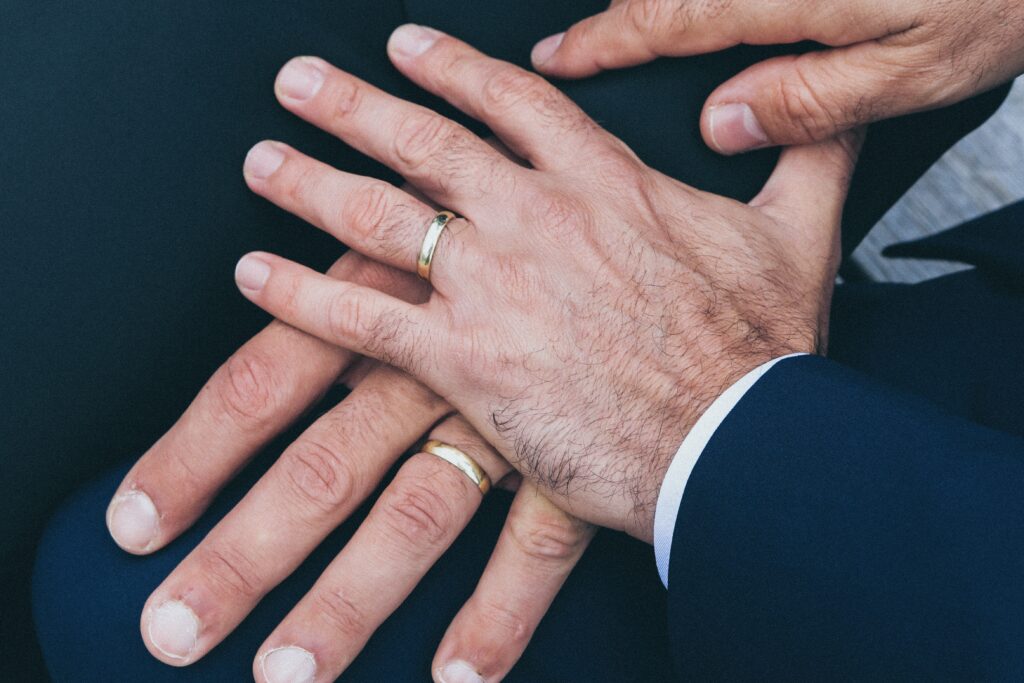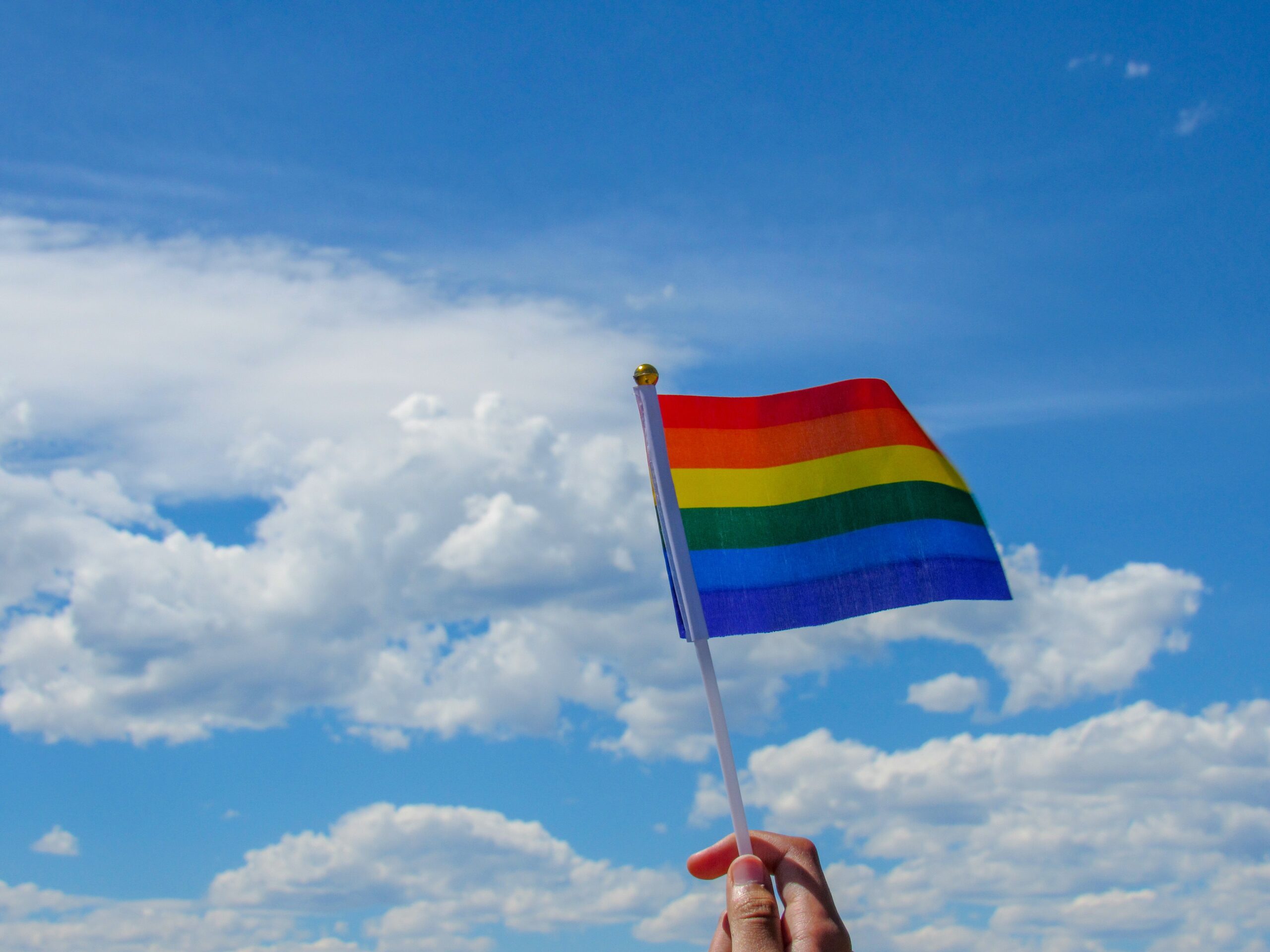I have identified seven features which distinguish gay and lesbian ceremonies from traditional wedding rituals, even as they are rooted in the traditional ceremony.
1. Recognition of the existing history of the couple
Since getting married has not been an option until recently, the couple may have considered themselves fully committed for years. Retrospective affirmation of what has already been is often an important part of the ceremony; one couple concerned that they not be perceived as just starting out added the phrase “as we have done for the last ten years” to their vows and ketubah.
2. The centrality of blessing
In marked contrast to traditional weddings, in gay and lesbian ceremonies the absence of the family of origin is often conspicuous. Even when present, family members may be uncomfortable or withdrawn. The couple who are celebrating are seeking the blessing—spoken and ritually enacted—of Judaism, family, and community. This may be represented by the rabbi’s officiation, the celebration in the synagogue, and/or the presence of family, friends and community who have gathered to affirm their support of the individuals and their commitment. No less important is the explicit affirmation of God’s blessing. The seven blessings locate this union in the context of God’s unfolding work of creation.
3. Witnessing
The signing of the ketubah by two witnesses in accordance with historical Jewish practice helps mark the ceremony as standing in the tradition of the Jewish people. For gay and lesbian people, who have often had to live in hiding, the public reading of a document affirming their love and commitment is a liberating and joyful moment.
4. Link to the covenant
Besides the ketubah, the use of other traditional symbols and gestures and words help locate this ceremony in the Jewish tradition. For people who often feel that they are on uncharted ground, these links to an ancient tradition are an important connection. For guests and community, the presence of familiar words and symbols helps everyone present understand how to relate to this ceremony (i.e., it is just like a wedding).
5. Link to the community
The lives of many gay and lesbian people are intimately bound up with those of their extended family and community. Some people are concerned that they not be perceived as withdrawing from their prior connections; others simply wish to emphasize that their relationship exists in the context of a wider community and that they depend on the community for continued support. Accordingly, it may be appropriate to find ways—in words or ritual—to acknowledge the communal context in which the ceremony takes place. This will be particularly important if it is the first one of its kind in a particular community, if the couple has had to overcome obstacles or controversy or when the ceremony has a strong retrospective dimension.
6. Formal Changes
While the ceremony is always personalized through the selection of readings and music, and the rabbi’s derash, I have made several changes from the from of the ceremony as presented in the Rabbi’s Manual.
These include:
1) I give an opportunity early on in the ceremony for remembrances of people who have died or acknowledging the painful absence of those who would not attend;
2) I do not say k’dat Moshe v’Yisrael (according to the law of Moses and Israel) as the ceremony is not a halachic (Jewishly legal) one nor does it claim to stand in the halachic tradition (as the Reform liturgy does). However, it is most definitely in the spirit of the tradition; accordingly, I often say: … in the spirit of our people [our people being pleasantly ambiguous]; in the spirit of Moses, Miriam and the Jewish people; and/or … before God and before these witnesses [or: this community];
3) The seven blessings are the most problematic text. Usually, the blessings are chanted or read in Hebrew and then read in an English interpretive setting; a creative translation which finesses the problematic language is a hallmark of our published liturgy. I do not say ha-kallot (the brides) or ha-hatanim (the grooms) in place of chatan va’kallah (bride and groom); I usually substitute ra-im/ot ha-ahuvim/ot (friends and lovers). In the seventh blessing, I substitute kol ahavah v’kol achvah (the voice of the love and friendship) for kol hatan and kol kallah (the voice of groom and bride).
7. Adding Explicit gay or lesbian content
I try to include readings from gay and lesbian Jewish sources. Sources range from the Bible to Yehudah ha-Levi and other medieval Spanish Hebrew poets, to modern authors like Muriel Ruykeiser or Adrienne Rich. Obviously, these are in addition to the readings which all rabbis already have about home, family, love, commitment, and the like….
Creating new liturgy can be done with integrity. Authenticity requires the presence of two elements: the whole and honest telling of our stories, and the invocation of God, Torah and Israel consistently with the spirit of the Jewish tradition, the language of the Jewish community and the conscience of the officiant and celebrants. The outcome will be moments which fulfill the instruction: Let us renew the old and sanctify the new.
Excerpted from “Creating New Lifecycle Rituals,” a paper delivered at the CCAR convention, April, 1992. Copyright Yoel H. Kahn 1992. Used by permission.












